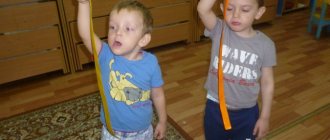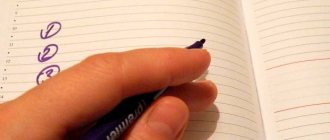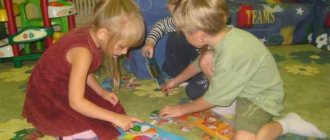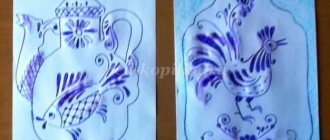Important aspects of the theory
A set of breathing exercises aimed at strengthening the health of children, as well as teaching them to relax, which is most important for hyperactive children, is called breathing exercises.
Goals and objectives of breathing exercises in the senior group of preschool educational institutions
The goals of gymnastics are as follows:
- teach every child to breathe correctly and deeply;
- train the ability to coordinate your movements;
- develop the speech apparatus;
- have fun and useful time.
Breathing exercises for children should be of a playful nature, so you can develop the force of the exhaled air stream using masks of natural phenomena and the corresponding precipitation
Achieving the set goals is carried out by solving a number of tasks:
- create favorable conditions to provide all tissues of the body with oxygen;
- develop and strengthen respiratory muscles;
- develop vocal cords.
In addition, simple exercises help develop the sound culture of speech and help correct sound pronunciation disorders in children (for example, gymnastics with onomatopoeia). This is especially true for older preschoolers, in whom defects are more clearly identified than in younger children with not yet fully formed speech. Therefore, sets of breathing tasks are actively used in speech therapy groups.
This is interesting. If a child does not have problems with speech, then breathing exercises will in no way harm him.
The benefits of breathing exercises for a child are also obvious during the treatment of colds and other diseases. It is worth noting the fact that this gymnastics has practically no contraindications. Although if parents are unsure whether a particular exercise is suitable for their baby, they can consult a pediatrician.
The goals and objectives of the developed sets of exercises are the same for children of any age. However, the sets of tasks will differ, which is associated with the use of available tools that are interesting and useful for a particular period of development.
For breathing exercises, you can use attributes of board games, pieces of cotton wool, stickers, etc.
Types of breathing exercises
There are several original versions of the exercises, and the teacher has the right to choose one of the complexes or make a prefabricated one. Domestic kindergartens work using a number of methods:
- gymnastics by Strelnikova (author of the most popular breathing exercises);
- Frolov method (most of the exercises are performed on a specially designed device designed to improve the contractile function of the lungs, which helps cleanse them and saturate them with oxygen);
- Buteyko method (aimed at eliminating deep breathing; due to shallow inhalation and long exhalation, the lungs are saturated with oxygen, the bronchi and blood vessels dilate);
- breathing training according to the program M.L. Lazarev “Hello” (elements of breathing music therapy are used - singing, reading poetry, playing wind instruments).
This is interesting. Initially, Strelnikova’s gymnastics was used in working with professional vocalists to restore lost voices. This is how the first author's complex appeared.
Exercises can serve as the basis for individual or team competitions, for example, a variation of the “Football Players” exercise, when children must use a stream of exhaled air to deliver a thread ball to the target faster than their opponent.
Methods and techniques for performing exercises
According to the requirements of the Federal State Educational Standard, breathing exercises are carried out in an accessible and interesting form for children - a game . There are different types of exercises:
- working with different ways to inhale and exhale without improvised means;
- strengthening the respiratory system with the help of improvised means (balloons, cotton balls, soap bubbles, harmonica, pipes, cut-out paper figures, cocktail straws, etc.).
Breathing exercises can be done as follows:
- rhythmic alternation of inhalation and exhalation;
- imitation of inflation;
- blowing/deflating (soap bubbles/light balls, such as cotton balls);
- whistling;
- playing wind instruments.
The same exercise can be played out in different ways: just change the scenery for football to turn into a game of “Feed the Caterpillar”
Requirements for performing gymnastics
Despite the apparent ease, performing the exercises is not so simple. But thanks to the playful form and compliance with the rules, breathing exercises are one of the favorite activities for children in the group, and the kids don’t even notice that they have seriously worked on improving their health.
- In the older group, exercises are carried out 2 times a day for 10 minutes, no earlier than an hour after meals. The best option is ten minutes in the morning while charging.
- In the summer, children go outside to complete tasks.
- Before you start working, the room needs to be well ventilated and wet cleaned.
- In order for the children to be involved in the process of execution, each exercise must be called an original and, if possible, funny name.
- The group must have pictures that help children better understand the plot that accompanies the performance of gymnastics movements.
- Parents and teachers must act harmoniously, since performing the exercises does not tolerate idle relaxation and forgetfulness. Parents should know what kind of gymnastics the kids do in the group and periodically repeat the exercises, especially on weekends and during the holidays.
Parents should repeat with their children the breathing exercises they learned in kindergarten, for example, blowing on dandelions to train the power of exhalation.
Precautionary measures
When performing a complex of breathing exercises, you need to follow simple rules:
- Feeling hungry can lead to dizziness, so the child should eat well and wait half an hour after eating.
- The child must be in a good mood and be interested in the lesson.
- Be careful with asthmatics - they may have an attack. If a child suffers from asthma, the presence of a doctor with the necessary medications is necessary.
- Start with a few exercises and increase the load gradually to determine whether a set of breathing exercises will cause harm.
- If you experience shortness of breath, muscle pain, or pale skin, you should stop exercising and notify your doctor about the problem in order to establish the reason for the body’s non-acceptance of breathing exercises.
- You need to breathe only clean air - go outside, or, in case of bad weather, study in a ventilated room. Please note that in an unventilated room there can be many microbes in the air, including pathogens.
Card file of breathing exercises in the senior group
As a rule, each teacher has a card index of exercises for the development of the respiratory system, that is, a certain complex in which each exercise has its own purpose. This gymnastics is performed in a certain order, so that it is easier for children to navigate the tasks, and the time for performing the complex is distributed rationally.
Basic complex
The basic complex was created based on the developments of A.N. Strelnikova, but supplemented with content relevant to children (for example, rhymes). The complex includes exercises that form the basis of breathing exercises, aimed at lengthening and intensifying exhalation. All movements are performed at a calm pace, without jerking. You need to start with 4-5 repetitions of each exercise, gradually the frequency of execution increases by 1-2 times and reaches 10.
"Watch"
The clock moves forward, / Leads us behind it.
Instructions:
- We place the legs at shoulder level, and place the arms along the body.
- With straight arms we make movements reminiscent of the movement of the hands of a clock - “Tick”, arms forward, inhale.
- We move our hands behind our backs - “So,” exhale.
"Cockerel"
The rooster flapped his wings, / He suddenly woke us all up.
Instructions:
- We place the legs shoulder-width apart, and lower the arms at the seams.
- We move our arms to the sides and inhale.
- We clap our hands on the thighs - “Ku-ka-re-ku”, exhale.
"Pump"
We will pump up water / To water the flowers.
Instructions:
- We place the legs at shoulder level, lift the arms up without bending them.
- Bend your body to the right and inhale.
- We lower our hands down with a sliding movement and, pronouncing the sound “Ssss,” exhale.
"I'll be big"
I want to grow up quickly, / Do good for people.
Instructions:
- We stand straight, legs together.
- We place our arms to the sides parallel to the floor, then lift and stretch upward on our toes, inhale.
- We make a downward movement with our hands, stand on a full foot and, saying: “Uuuhhh,” exhale.
"Merry little engine"
The sun is shining, / The clouds are floating, / The little train is moving: / Chukh-chukh-chukh-chukh-chukh.
Instructions:
- We walk around the room, making movements with our hands. We accompany the mise-en-scène with the sound “Choo-Choo.”
- We make a stop and as we exhale we say: “Tu-tuuuuuu.”
"Semaphore"
The most important one on the road, / There is no worry with him.
Instructions:
- We sit on a chair, legs together.
- We swing our arms to the sides while inhaling.
- We lower it slowly, exhaling for a long time with the sound “Ssss.”
At the end of the complex, you must perform 2 exercises to stabilize breathing.
Quietly, quietly we will breathe, / We will hear our heart.
Instructions:
- The initial pose is standing, arms extended at the sides.
- We inhale through the nose until the air begins to expand the chest.
- We freeze for 4–5 seconds.
- We also exhale through the nose.
- Repeat 2-3 times.
Breathe with one nostril, / And peace will come to you.
Instructions:
- We close the nostril of the same name with the index finger of our right hand, and inhale quietly and continuously with our left nostril.
- We open the right nostril and close the left one with the index finger of the same hand.
- Exhale deeply through the right nostril.
- We do 2 approaches.
Card index of exercises on various topics
Breathing exercises are selected not only according to goals (although this is a fundamental factor in the choice), but also according to the topics that the group classes are devoted to, in this case, children 5–6 years old. These exercises are especially often used as physical education. In this way, the teacher solves the problem of comprehensive education in a preschool institution. A significant part of the exercises involves onomatopoeia, which allows you to correct speech defects in older children.
Theme: "Autumn"
- "Angry hedgehog." Goal: work on the smoothness and duration of exhalation. This exercise can be included in the list of current tasks when kids talk about animals that, even in the wild, live as close to humans as possible. Instructions:
- Introduction - 2 minutes. “Guys, stand so that your feet are at shoulder level.”
- “Now we bend as much as possible, trying to hug our chest, lower our head and, exhaling, say: “Pfff” - 1 minute.
- But then the hedgehog was treated to a delicious gingerbread, and he became joyful. “F-r-r” - 1 minute.
- Repeat 4-5 times. “Well done!”
- "Leaf fall." To complete this exercise you will need leaves of different types of trees cut out of colored paper. Instructions:
- Introduction - 1 minute.
- We give each child several leaves cut out of thin colored paper and ask them to blow on them for 2 minutes. Please note that the leaves should be cut into different shapes for different trees. And while doing the exercise, explain which leaf fell from which tree.
- Repeat 3-5 times - 2-3 minutes. “They did a great job, and at the same time they remembered the names of the trees!”
Video: breathing exercises in the senior group, exercise “In the autumn forest”
Topic: "Professions"
- "Adjuster". The goal is to develop a breathing apparatus. He will show us the right path, / He will show us all the turns. Instructions:
- We stand straight, legs at shoulder level, raise one arm up, and move the other to the side - 1 minute.
- Inhale through your nose for ½ minute.
- We change the position of the hands while exhaling slowly, saying “r-r-r-r” - 1 minute.
- Repeat 5-6 times - 2-3 minutes.
- "Footballers." A special place in the process of performing physical education is occupied by exercises that are performed using improvised means. Such tasks help maintain children's interest for a long time. Goal: learn to direct the stream of exhaled air. Instructions:
- Introduction - 2 minutes.
- We sit down with the children and place 2 cotton balls on a sheet of thick paper or cardboard. We blow on them so that they fall to the floor - 2 minutes.
- Repeat 5-6 times - 1-2 minutes.
Topic: “Seasons”
- "Little Artists" An excellent exercise that, for example, will help brighten up the minutes of waiting in bad weather. Goal: learn to hold your breath and exhale completely. Instructions:
- Children are asked to exhale several times into the window - 1 minute. Then the teacher asks you to draw some kind of picture on this piece. The teacher’s task is the point of intersection with the specific topic of the lesson.
- The teacher discusses the resulting drawings with the children.
- "Butterflies". Goal: to train the skill of giving a certain direction to the stream of exhaled air. Instructions:
- We cut butterflies out of paper, attach them to long threads and place them either on the ceiling or on the wall.
- Children blow on insects so that they “fly”.
Children enjoy doing breathing exercises using available tools.
Tolkachev gymnastics
Tolkachev's breathing exercises are very simple and interesting; they can be performed when you need to relax.
- Rocking chair - sitting, place your hands on your knees. We rock back and forth with the sound “Fr-o-o-h.”
- The Christmas tree is growing - stand straight, arms down, legs apart, squat as you exhale with the word “Fear-x-x”, raise your arms in front of you, while inhaling we rise to the starting position.
- Bunny - we stand with our legs apart and our arms down, squatting, as we exhale we say “fr-r”, bend our elbows, bringing the backs of our hands to our shoulders, like a bunny. We do it slowly.
- Geese hiss - spread your legs, keep your feet parallel, gymnastic stick in the crook of your arms, lean forward with the sound “sh-sh-sh”, stretch your neck and look forward.
- We press our knees - we sit down with our legs extended, a gymnastic stick under our knees, we pull our legs behind our knees with a stick to our chest with the sound “oof”, as we exhale we straighten our legs and lower our arms again.
- Rowers - sit down and spread your legs, stick at your chest. We bend forward while exhaling with the sound “gu-u”, touch our toes with the stick, straighten up again, bringing the stick to our chest.
Breathing exercises in classes at preschool educational institutions
Everything is good in moderation - this principle also applies to respiratory exercises. It takes 10 to 12 minutes to complete a set of 6–7 tasks. In this case, time is distributed between exercises as follows:
- introductory part - exercises that do not require complex combinations of movements, inhale and exhale at a normal pace - 3 minutes;
- the main part - tasks with a combination of inhalation-exhalation tempo and complicated movements, as well as changing body posture - 5 minutes;
- the final part is exercises to restore the rhythm of breathing, the body position is static - 2-3 minutes.
It is also worth taking into account the fact that often 1-2 breathing exercises are included in the tasks for physical education classes. In this case, time is allocated for their completion in proportion to other tasks.
Table: example of a breathing exercises summary (fragment)
| Author | Olga Smetskaya, teacher at MADOU No. 9, Shebekino |
| Name | “Methodology for conducting breathing exercises according to A. Frolov in the senior group” |
| Content | <...Educator: Guys, Winnie the Pooh bear came to visit us from the forest. He's so sick he can't even speak. The bear cub has a sore throat, headache, high fever, runny nose and cough. He told me in my ear that he couldn’t recover. Neither pills nor medicines help, even your favorite honey does not cure Winnie the Pooh. The weather is warm outside, he wants to walk and play with his friends in the forest, but his cold does not go away. Winnie the Pooh, it's a pity that you got sick. And the kids in our kindergarten don’t get sick, they don’t have a runny nose, cough, or fever. Look, Winnie the Pooh, how healthy, cheerful and active they are. Guys, the little bear is asking, what should you do to avoid getting sick? (Do exercises, wash, harden, play sports). Our children also do breathing exercises every day in kindergarten. Don't you know what breathing exercises are? The guys will tell you everything and show you everything. Winnie the Pooh, you need to train not only the body, but also the lungs, because breathing is an important function on which our health depends. We breathe oxygen, which penetrates all the cells of our body and helps them work. That's why the guys do breathing exercises. Children show 1-2 exercises...> <...Educator: Guys, how do breathing exercises help you? (We have become healthy, strong, cheerful, beautiful). Winnie the Pooh, get well soon, also toughen up and do breathing exercises. And you will be, like our guys, healthy and cheerful. We look forward to your visit next time healthy. Guys, say goodbye to our guest and wish him all the best. To get health, you don’t have to go far. We need to try ourselves, and everything will work out. If you want to be healthy, Do without doctors - Temper yourself, wash yourself, Do different sports...> |
| Quote from: https://www.maam.ru/detskijsad/metodika-provedenija-dyhatelnoi-gimnastiki-po-a-frolovu-v-starshei-grupe.html | |
Photo gallery: a set of exercises in pictures
The “Clock” exercise needs to be repeated 10–12 times. Correct breathing is the key to excellent playing of wind instruments. The “Locomotive” exercise will help pass the time in line at the doctor or hairdresser. The “On the horizontal bar” exercise can be included in the warm-up before physical education. Exercises with the ball are one of the children's favorites Children enjoy doing exercises that are about growing up
Breathing exercises are not only an effective way to preserve and strengthen the immune system and develop speech, but also a fun game. Therefore, children do not have any difficulties performing the exercises, and interest and pleasure accompany the educational process. The main thing is to artistically present the plot of the fun, as well as methodically and competently weave it into the overall outline of the lesson.










